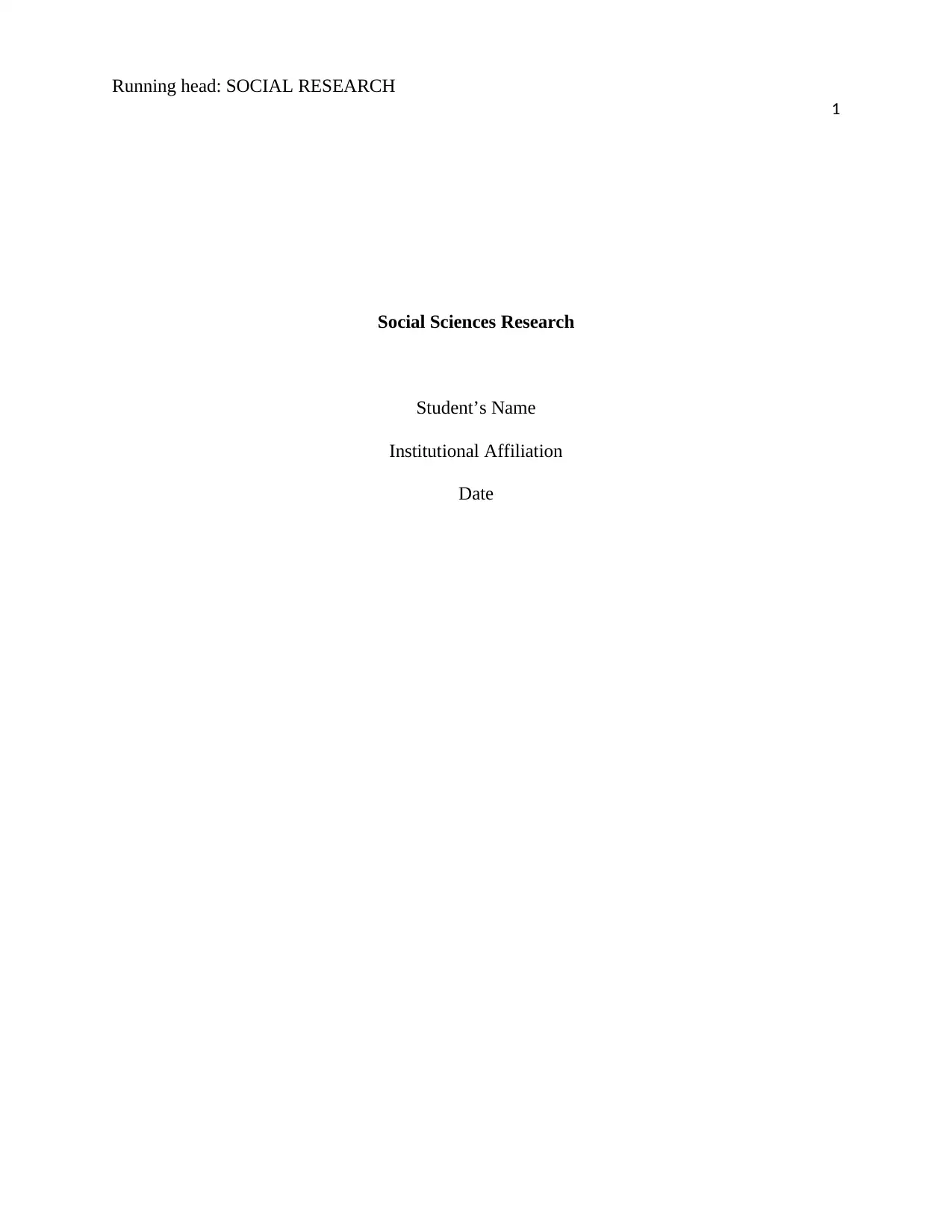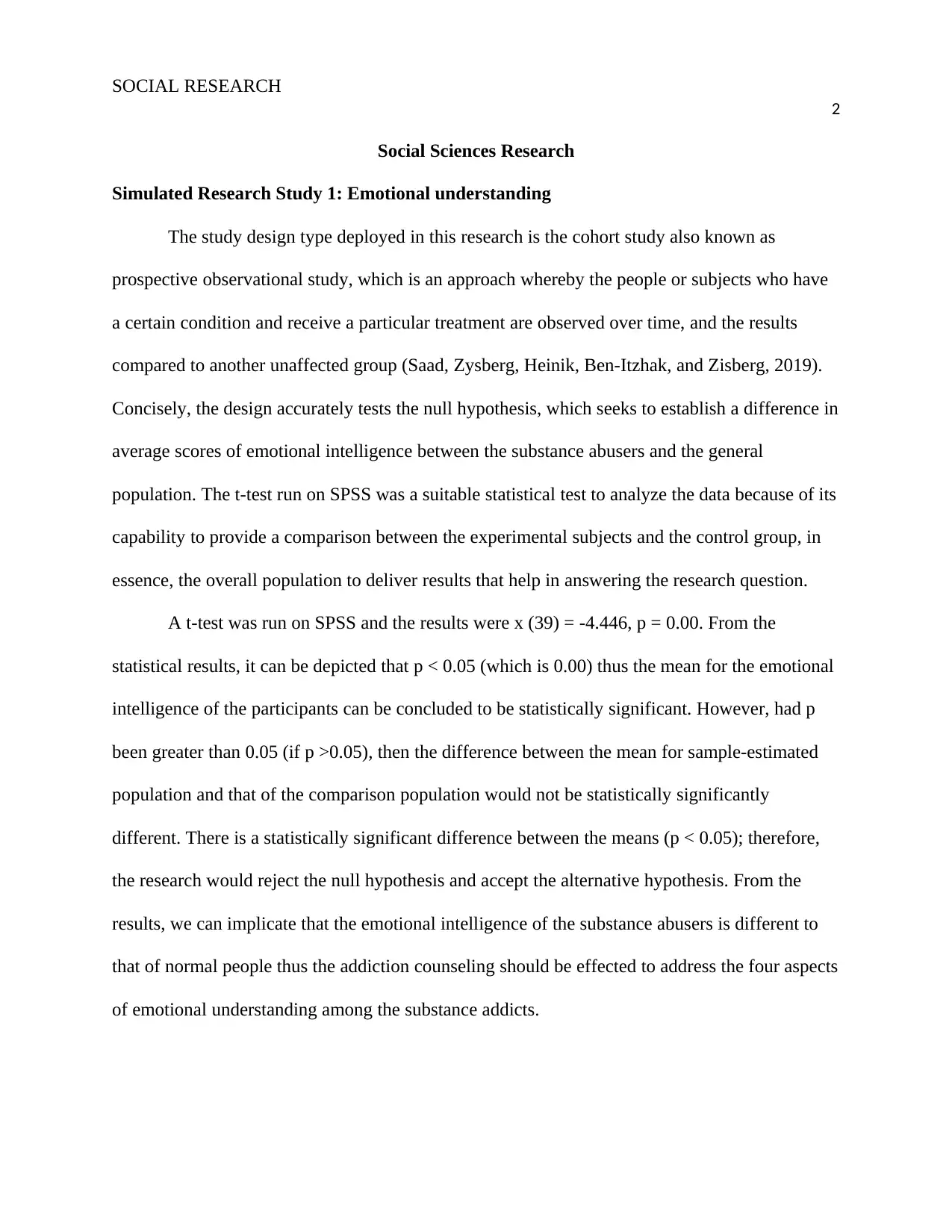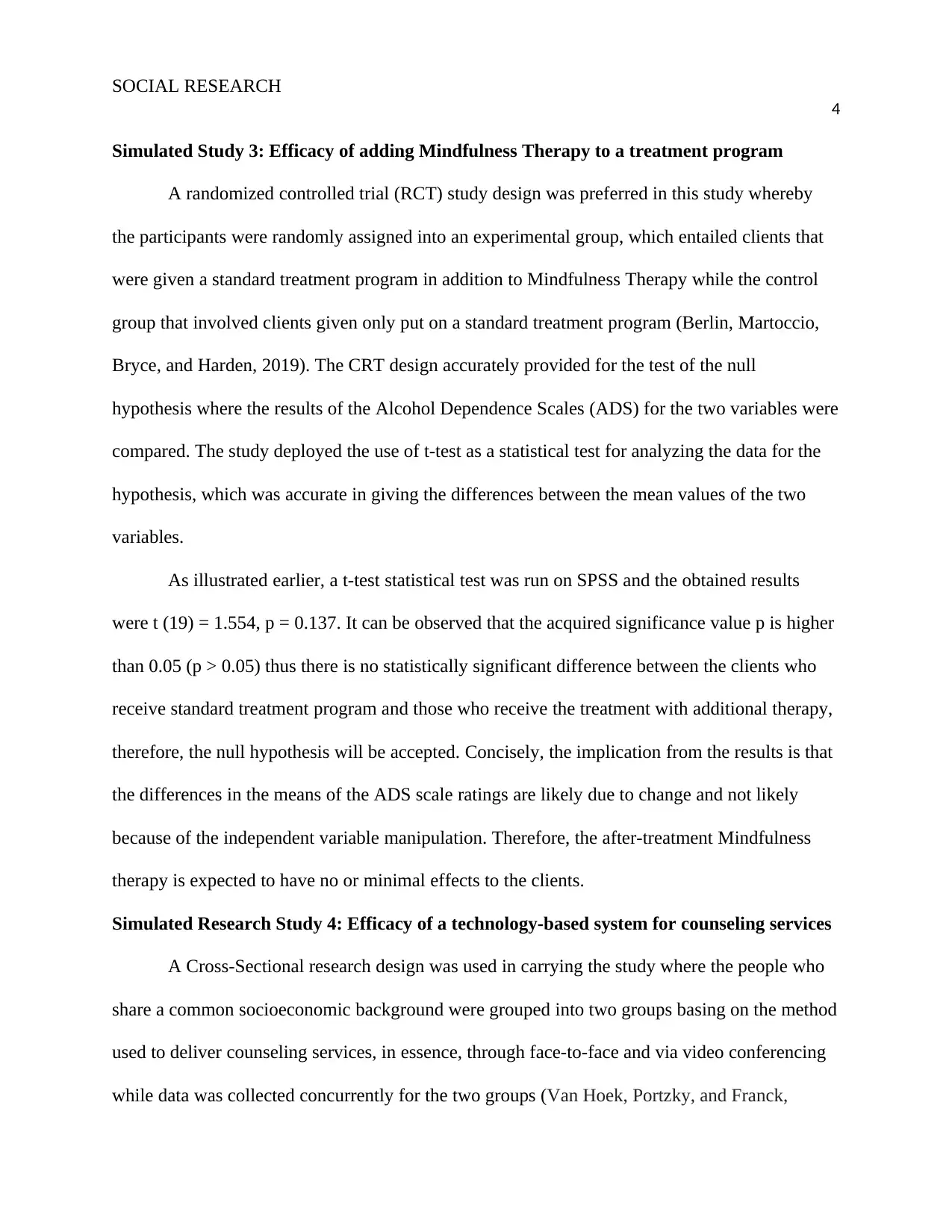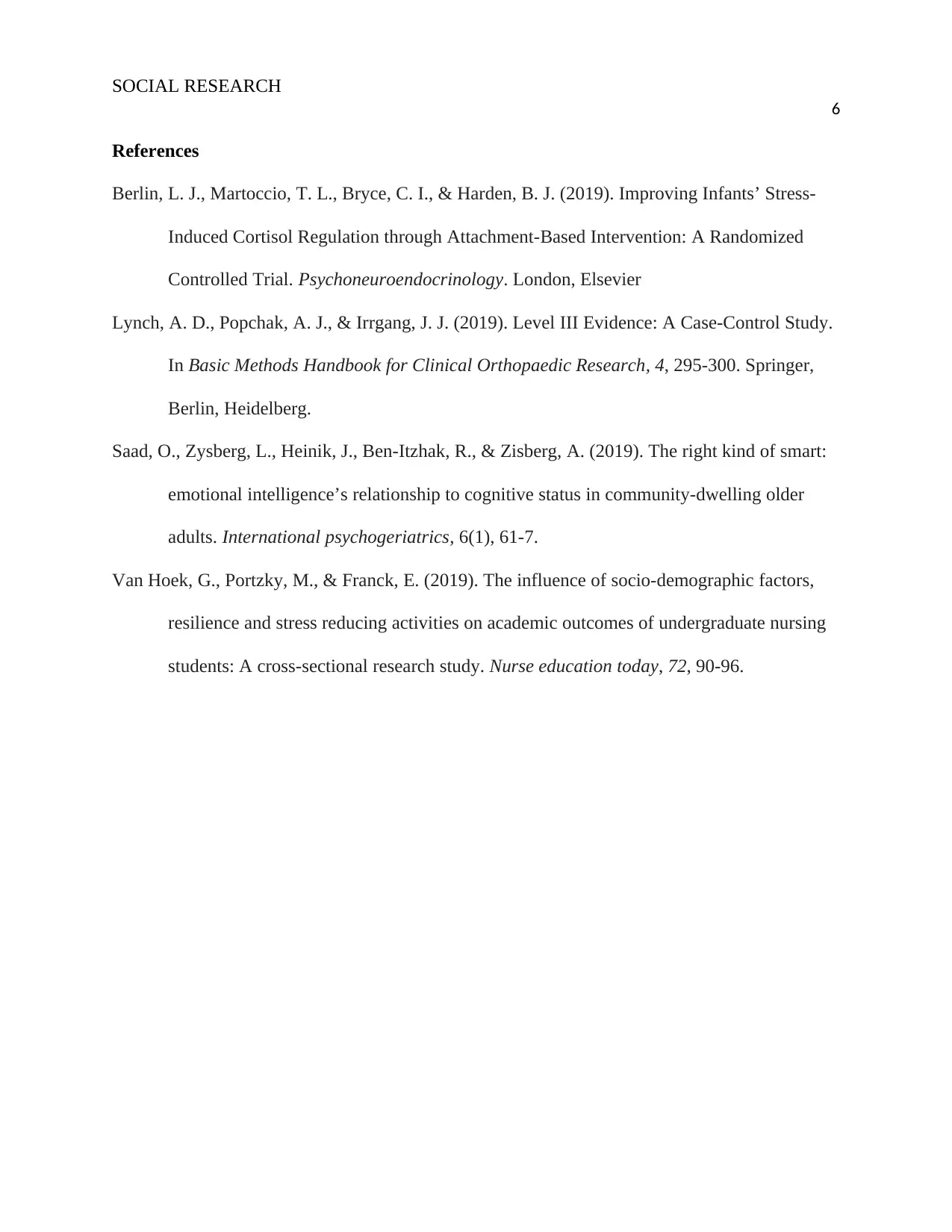MAAC 515: Evaluating Results & Implications in Social Research
VerifiedAdded on 2023/04/24
|6
|1501
|347
Report
AI Summary
This report presents an analysis of four simulated research studies in the social sciences. The first study examines emotional understanding among substance abusers using a cohort study design and a t-test, finding a statistically significant difference. The second study uses a case-control design and Chi-Square test to analyze job prevalence options for postgraduates, revealing no significant difference in employment frequencies across different organizations. The third study employs a randomized controlled trial to assess the efficacy of mindfulness therapy, with t-test results indicating no statistically significant benefit. Finally, the fourth study utilizes a cross-sectional design to compare technology-based counseling services with face-to-face counseling, finding no significant difference in outcomes based on t-test results. For students seeking similar solved assignments and study resources, Desklib offers a comprehensive platform.

Running head: SOCIAL RESEARCH
1
Social Sciences Research
Student’s Name
Institutional Affiliation
Date
1
Social Sciences Research
Student’s Name
Institutional Affiliation
Date
Paraphrase This Document
Need a fresh take? Get an instant paraphrase of this document with our AI Paraphraser

SOCIAL RESEARCH
2
Social Sciences Research
Simulated Research Study 1: Emotional understanding
The study design type deployed in this research is the cohort study also known as
prospective observational study, which is an approach whereby the people or subjects who have
a certain condition and receive a particular treatment are observed over time, and the results
compared to another unaffected group (Saad, Zysberg, Heinik, Ben-Itzhak, and Zisberg, 2019).
Concisely, the design accurately tests the null hypothesis, which seeks to establish a difference in
average scores of emotional intelligence between the substance abusers and the general
population. The t-test run on SPSS was a suitable statistical test to analyze the data because of its
capability to provide a comparison between the experimental subjects and the control group, in
essence, the overall population to deliver results that help in answering the research question.
A t-test was run on SPSS and the results were x (39) = -4.446, p = 0.00. From the
statistical results, it can be depicted that p ˂ 0.05 (which is 0.00) thus the mean for the emotional
intelligence of the participants can be concluded to be statistically significant. However, had p
been greater than 0.05 (if p ˃0.05), then the difference between the mean for sample-estimated
population and that of the comparison population would not be statistically significantly
different. There is a statistically significant difference between the means (p ˂ 0.05); therefore,
the research would reject the null hypothesis and accept the alternative hypothesis. From the
results, we can implicate that the emotional intelligence of the substance abusers is different to
that of normal people thus the addiction counseling should be effected to address the four aspects
of emotional understanding among the substance addicts.
2
Social Sciences Research
Simulated Research Study 1: Emotional understanding
The study design type deployed in this research is the cohort study also known as
prospective observational study, which is an approach whereby the people or subjects who have
a certain condition and receive a particular treatment are observed over time, and the results
compared to another unaffected group (Saad, Zysberg, Heinik, Ben-Itzhak, and Zisberg, 2019).
Concisely, the design accurately tests the null hypothesis, which seeks to establish a difference in
average scores of emotional intelligence between the substance abusers and the general
population. The t-test run on SPSS was a suitable statistical test to analyze the data because of its
capability to provide a comparison between the experimental subjects and the control group, in
essence, the overall population to deliver results that help in answering the research question.
A t-test was run on SPSS and the results were x (39) = -4.446, p = 0.00. From the
statistical results, it can be depicted that p ˂ 0.05 (which is 0.00) thus the mean for the emotional
intelligence of the participants can be concluded to be statistically significant. However, had p
been greater than 0.05 (if p ˃0.05), then the difference between the mean for sample-estimated
population and that of the comparison population would not be statistically significantly
different. There is a statistically significant difference between the means (p ˂ 0.05); therefore,
the research would reject the null hypothesis and accept the alternative hypothesis. From the
results, we can implicate that the emotional intelligence of the substance abusers is different to
that of normal people thus the addiction counseling should be effected to address the four aspects
of emotional understanding among the substance addicts.

SOCIAL RESEARCH
3
Simulated Research Study 2: Job prevalence options
The case-control study design was used in accomplishing the prevalent to employment
options research. Lynch, Popchak, and Irrgang (2019) acknowledged that in the case-control
design, the study begins with the outcomes and do not make a follow up afterward. The authors
explained that the researchers choose people with a particular case or result, (in essence, the
postgraduate employees in residential facilities, private practice, and community agencies in this
study) and then compare with another group that is not affected by the similar condition.
Concisely, the design accurately tests the null hypothesis by comparing the frequencies of
employment of the postgraduates in the three stated organizations. The use of Chi-Square
statistical tool on SPSS is suitable for analyzing the data since it determines an association or the
existence of a relationship between categorical variables, which are the expected and observed
employment frequencies in the three categories in this study.
A Chi-Square statistical test was run on SPSS and the results obtained were x (2, N = 30)
= 0.80, p = 0.67. From the findings, it can be deduced that the value of p is greater than 0.05
(0.67 ˃0.05) indicating that the result is not statistically significant; thus, the null hypothesis
which, asserts that there would be no difference in the frequency of the graduates who are
employed in the outlined categories would be accepted. Additionally, the obtained p-value (0.67)
implies that the probability of the Chi-Square statistic having 2 degrees of freedom is more than
the significance level thus the H0 cannot be rejected. Moreover, from the results, the implication
is that the frequency at which the postgraduates are employed in different organizations is nearly
similar. Therefore, it would be possible to predict the chances of a graduate student to get
employment in a certain organization.
3
Simulated Research Study 2: Job prevalence options
The case-control study design was used in accomplishing the prevalent to employment
options research. Lynch, Popchak, and Irrgang (2019) acknowledged that in the case-control
design, the study begins with the outcomes and do not make a follow up afterward. The authors
explained that the researchers choose people with a particular case or result, (in essence, the
postgraduate employees in residential facilities, private practice, and community agencies in this
study) and then compare with another group that is not affected by the similar condition.
Concisely, the design accurately tests the null hypothesis by comparing the frequencies of
employment of the postgraduates in the three stated organizations. The use of Chi-Square
statistical tool on SPSS is suitable for analyzing the data since it determines an association or the
existence of a relationship between categorical variables, which are the expected and observed
employment frequencies in the three categories in this study.
A Chi-Square statistical test was run on SPSS and the results obtained were x (2, N = 30)
= 0.80, p = 0.67. From the findings, it can be deduced that the value of p is greater than 0.05
(0.67 ˃0.05) indicating that the result is not statistically significant; thus, the null hypothesis
which, asserts that there would be no difference in the frequency of the graduates who are
employed in the outlined categories would be accepted. Additionally, the obtained p-value (0.67)
implies that the probability of the Chi-Square statistic having 2 degrees of freedom is more than
the significance level thus the H0 cannot be rejected. Moreover, from the results, the implication
is that the frequency at which the postgraduates are employed in different organizations is nearly
similar. Therefore, it would be possible to predict the chances of a graduate student to get
employment in a certain organization.
⊘ This is a preview!⊘
Do you want full access?
Subscribe today to unlock all pages.

Trusted by 1+ million students worldwide

SOCIAL RESEARCH
4
Simulated Study 3: Efficacy of adding Mindfulness Therapy to a treatment program
A randomized controlled trial (RCT) study design was preferred in this study whereby
the participants were randomly assigned into an experimental group, which entailed clients that
were given a standard treatment program in addition to Mindfulness Therapy while the control
group that involved clients given only put on a standard treatment program (Berlin, Martoccio,
Bryce, and Harden, 2019). The CRT design accurately provided for the test of the null
hypothesis where the results of the Alcohol Dependence Scales (ADS) for the two variables were
compared. The study deployed the use of t-test as a statistical test for analyzing the data for the
hypothesis, which was accurate in giving the differences between the mean values of the two
variables.
As illustrated earlier, a t-test statistical test was run on SPSS and the obtained results
were t (19) = 1.554, p = 0.137. It can be observed that the acquired significance value p is higher
than 0.05 (p ˃ 0.05) thus there is no statistically significant difference between the clients who
receive standard treatment program and those who receive the treatment with additional therapy,
therefore, the null hypothesis will be accepted. Concisely, the implication from the results is that
the differences in the means of the ADS scale ratings are likely due to change and not likely
because of the independent variable manipulation. Therefore, the after-treatment Mindfulness
therapy is expected to have no or minimal effects to the clients.
Simulated Research Study 4: Efficacy of a technology-based system for counseling services
A Cross-Sectional research design was used in carrying the study where the people who
share a common socioeconomic background were grouped into two groups basing on the method
used to deliver counseling services, in essence, through face-to-face and via video conferencing
while data was collected concurrently for the two groups (Van Hoek, Portzky, and Franck,
4
Simulated Study 3: Efficacy of adding Mindfulness Therapy to a treatment program
A randomized controlled trial (RCT) study design was preferred in this study whereby
the participants were randomly assigned into an experimental group, which entailed clients that
were given a standard treatment program in addition to Mindfulness Therapy while the control
group that involved clients given only put on a standard treatment program (Berlin, Martoccio,
Bryce, and Harden, 2019). The CRT design accurately provided for the test of the null
hypothesis where the results of the Alcohol Dependence Scales (ADS) for the two variables were
compared. The study deployed the use of t-test as a statistical test for analyzing the data for the
hypothesis, which was accurate in giving the differences between the mean values of the two
variables.
As illustrated earlier, a t-test statistical test was run on SPSS and the obtained results
were t (19) = 1.554, p = 0.137. It can be observed that the acquired significance value p is higher
than 0.05 (p ˃ 0.05) thus there is no statistically significant difference between the clients who
receive standard treatment program and those who receive the treatment with additional therapy,
therefore, the null hypothesis will be accepted. Concisely, the implication from the results is that
the differences in the means of the ADS scale ratings are likely due to change and not likely
because of the independent variable manipulation. Therefore, the after-treatment Mindfulness
therapy is expected to have no or minimal effects to the clients.
Simulated Research Study 4: Efficacy of a technology-based system for counseling services
A Cross-Sectional research design was used in carrying the study where the people who
share a common socioeconomic background were grouped into two groups basing on the method
used to deliver counseling services, in essence, through face-to-face and via video conferencing
while data was collected concurrently for the two groups (Van Hoek, Portzky, and Franck,
Paraphrase This Document
Need a fresh take? Get an instant paraphrase of this document with our AI Paraphraser

SOCIAL RESEARCH
5
2019). The design accurately tests the hypothesis by comparing the means of the results of the
ADS scores for the two groups at the end of the study. However, the t-test tool run on SPSS was
used to analyze the data correctly for hypothesis testing by comparing the variables.
The t-test for independent sample test run on SPSS for the group statistics, and the
obtained results were t (38) = 0.26, p = 0.74 (for the sig. read from the first row). From the
results, it is evident that p ˃ 0.05 (in essence, 0.74 ˃ 0.05) indicating that the variability of the
groups is about the same meaning that the scores from the two scales of ADS scale do not vary
too much from each other. Moreover, p = 0.80 (read from sig. (2-tailed)) which is higher than
0.05 depicting that there is no statistical significance between the two sets of data thus the null
hypothesis which claims that there will be no differences in scores on the ADS between video
conferencing and face-to-face will be accepted. From the analysis of the findings, the implication
is that the differences in means of the scores for the two groups are likely because of change are
not probably due to manipulation of the independent variable thus both the two approaches of
delivering counseling are most likely to have similar impacts.
5
2019). The design accurately tests the hypothesis by comparing the means of the results of the
ADS scores for the two groups at the end of the study. However, the t-test tool run on SPSS was
used to analyze the data correctly for hypothesis testing by comparing the variables.
The t-test for independent sample test run on SPSS for the group statistics, and the
obtained results were t (38) = 0.26, p = 0.74 (for the sig. read from the first row). From the
results, it is evident that p ˃ 0.05 (in essence, 0.74 ˃ 0.05) indicating that the variability of the
groups is about the same meaning that the scores from the two scales of ADS scale do not vary
too much from each other. Moreover, p = 0.80 (read from sig. (2-tailed)) which is higher than
0.05 depicting that there is no statistical significance between the two sets of data thus the null
hypothesis which claims that there will be no differences in scores on the ADS between video
conferencing and face-to-face will be accepted. From the analysis of the findings, the implication
is that the differences in means of the scores for the two groups are likely because of change are
not probably due to manipulation of the independent variable thus both the two approaches of
delivering counseling are most likely to have similar impacts.

SOCIAL RESEARCH
6
References
Berlin, L. J., Martoccio, T. L., Bryce, C. I., & Harden, B. J. (2019). Improving Infants’ Stress-
Induced Cortisol Regulation through Attachment-Based Intervention: A Randomized
Controlled Trial. Psychoneuroendocrinology. London, Elsevier
Lynch, A. D., Popchak, A. J., & Irrgang, J. J. (2019). Level III Evidence: A Case-Control Study.
In Basic Methods Handbook for Clinical Orthopaedic Research, 4, 295-300. Springer,
Berlin, Heidelberg.
Saad, O., Zysberg, L., Heinik, J., Ben-Itzhak, R., & Zisberg, A. (2019). The right kind of smart:
emotional intelligence’s relationship to cognitive status in community-dwelling older
adults. International psychogeriatrics, 6(1), 61-7.
Van Hoek, G., Portzky, M., & Franck, E. (2019). The influence of socio-demographic factors,
resilience and stress reducing activities on academic outcomes of undergraduate nursing
students: A cross-sectional research study. Nurse education today, 72, 90-96.
6
References
Berlin, L. J., Martoccio, T. L., Bryce, C. I., & Harden, B. J. (2019). Improving Infants’ Stress-
Induced Cortisol Regulation through Attachment-Based Intervention: A Randomized
Controlled Trial. Psychoneuroendocrinology. London, Elsevier
Lynch, A. D., Popchak, A. J., & Irrgang, J. J. (2019). Level III Evidence: A Case-Control Study.
In Basic Methods Handbook for Clinical Orthopaedic Research, 4, 295-300. Springer,
Berlin, Heidelberg.
Saad, O., Zysberg, L., Heinik, J., Ben-Itzhak, R., & Zisberg, A. (2019). The right kind of smart:
emotional intelligence’s relationship to cognitive status in community-dwelling older
adults. International psychogeriatrics, 6(1), 61-7.
Van Hoek, G., Portzky, M., & Franck, E. (2019). The influence of socio-demographic factors,
resilience and stress reducing activities on academic outcomes of undergraduate nursing
students: A cross-sectional research study. Nurse education today, 72, 90-96.
⊘ This is a preview!⊘
Do you want full access?
Subscribe today to unlock all pages.

Trusted by 1+ million students worldwide
1 out of 6
Related Documents
Your All-in-One AI-Powered Toolkit for Academic Success.
+13062052269
info@desklib.com
Available 24*7 on WhatsApp / Email
![[object Object]](/_next/static/media/star-bottom.7253800d.svg)
Unlock your academic potential
Copyright © 2020–2025 A2Z Services. All Rights Reserved. Developed and managed by ZUCOL.





